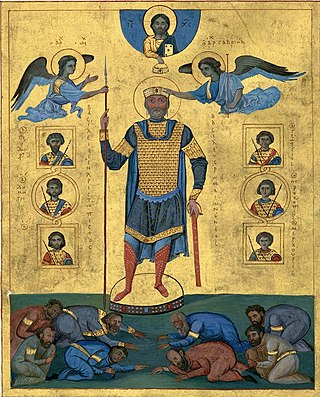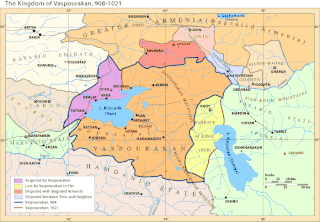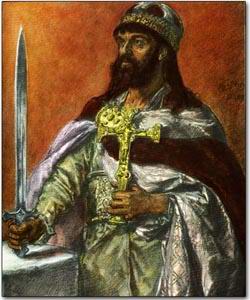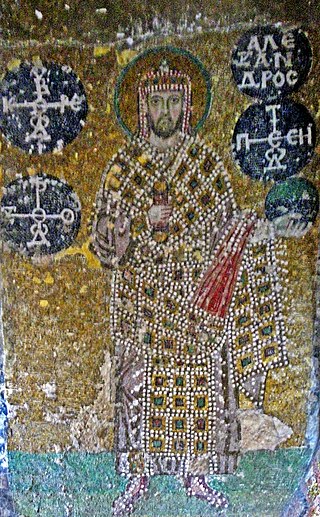Events
Japan
- Palace Scandal: Princess Consort Yasuko has an affair. Michinaga (her half-brother) investigates it secretly and finds out the truth about her pregnancy. Yasuko cries and repents. Yasuko leaves the palace under the patronage of Empress Dowager Senshi and Michinaga (moved to his residence).[ citation needed ]
- Murasaki Shikibu starts to write The Tale of Genji .[ citation needed ]
- Ichimonjiya Wasuke, the oldest surviving wagashi store, is established as a teahouse adjacent to Imamiya Shrine.
- 10 January: Death of Empress Dowager Masako (empress consort of the late Emperor Reizei)[ citation needed ]
- 8 April: Fujiwara no Shoshi is promoted to Empress (Chugu), while there is another empress, Fujiwara no Teishi (kogo) - this is the first time that there are two empresses[ citation needed ]
Americas
- The Taíno have become the dominant culture of modern day Puerto Rico.[ citation needed ]
Christendom

- In continental Europe, the Holy Roman Empire established itself as the most powerful state. The Holy Roman Emperor Otto III made a pilgrimage from Rome to Aachen and Gniezno (Gnesen), stopping at Regensburg, Meissen, Magdeburg, and Gniezno. The Congress of Gniezno (with Bolesław I Chrobry) was part of his pilgrimage. In Rome, he built the basilica of San Bartolomeo all'Isola, to host the relics of St. Bartholomew.
- In the Kingdom of France, Robert II, the son of Hugh Capet, was the first King of the Capetian royal dynasty. The Byzantine Empire under the Macedonian dynasty was engaged in a long and hard war with the First Bulgarian Empire. In the year 1000, the Byzantine generals Theodorokanos and Nikephoros Xiphias captured the former Bulgarian capitals of Pliska and Great Preslav, along with Little Preslav, extending Byzantine control over the northeastern portion of the Bulgarian state (Mysia and Scythia Minor). At the same time, Byzantium was instrumental in the Christianization of the Kievan Rus' and of other medieval confederations of Slavic states.
- In Great Britain, a unified Kingdom of England had developed out of the various Anglo-Saxon kingdoms.
- In Scandinavia, Christianization was in its early stages, with the Althingi of the Icelandic Commonwealth embracing Christianity in the year 1000. On September 9, the King of Norway, Olaf Tryggvason, was defeated by the Scandinavian kingdoms of Denmark and Sweden in the Battle of Svolder. Sweyn I established Danish control over part of Norway. The city of Oslo was founded in Norway (the exact year is debatable, but the 1,000 year anniversary was held in the year 2000). It is known that in or around this year, Norse explorer Leif Erikson became the first European to land in the Americas, at L'Anse aux Meadows in modern-day Newfoundland.
- The papacy during this time was in a period of decline, in retrospect known as the saeculum obscurum ("Dark Age") or "pornocracy" ("rule of harlots"), a state of affairs that would result in the Great Schism between Roman Catholicism and Eastern Orthodoxy later in the 11th century.
- The Kingdom of Hungary was established in 1000 as a Christian state. In the next centuries, the Kingdom of Hungary became the pre-eminent cultural power in the Central European region. On December 25, Stephen I was crowned as the first King of Hungary in Esztergom.
- Sancho III of Navarre became King of Aragon and Navarre. The Reconquista was gaining some ground, but the southern Iberian peninsula would still be dominated by Islam for centuries to come; Córdoba at this time was the world's largest city with 450,000 inhabitants.
- In the Kingdom of Croatia the army of the Republic of Venice led by Doge Pietro II Orseolo conquered the island of Lastovo.
- The Château de Goulaine vineyard was founded in France.
- The archdiocese in Gniezno was founded; the first archbishop was Gaudentius (Radim), from Slavník's dynasty, and dioceses in Kołobrzeg, Kraków and Wrocław.
- The Bell foundry was founded in Italy by Pontificia Fonderia Marinelli.
Islamic world
The Islamic world was in its Golden Age; still organised in caliphates, it continued to be dominated by the Abbasid Caliphate, with the Caliphate of Córdoba to the west, and experienced ongoing campaigns in Africa and in India. At the time, Persia was in a period of instability, with various polities seceding from Abbasid rule, among whom the Ghaznavids would emerge as the most powerful.
The Islamic world was reaching the peak of its historical scientific achievements. Important scholars and scientists who flourished in AD 1000 include Abu al-Qasim (Abcasis), Ibn Yunus (publishes his astronomical treatise Al-Zij al-Hakimi al-Kabir in Cairo in c. 1000), Abu Sahl al-Quhi (Kuhi), Abu-Mahmud al-Khujandi, Abu Nasr Mansur, Abu al-Wafa, Ahmad ibn Fadlan, Al-Muqaddasi, Ali Ibn Isa, and al-Karaji (al-Karkhi). Ibn al-Haytham ( Book of Optics ), Avicenna, Averroes, and Abu Rayhan al-Biruni all flourished around the year 1000.
By this time, the Turkic migration from the Eurasian Steppe had reached Eastern Europe, and most of the Turkic tribes (Khazars, Bulghars, Pechenegs etc.) had been Islamized.
Babylon abandoned
Babylon was abandoned around this year.




